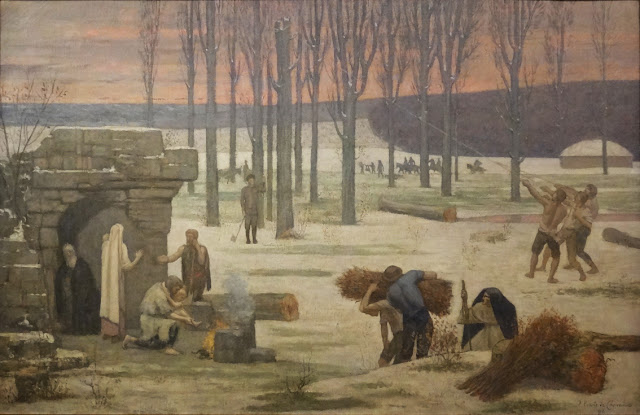“Sometimes our fate resembles a fruit tree in winter. Who would think that those branches would turn green again and blossom, but we hope it, we know it.” - Johann Wolfgang von Goethe
This afternoon we went to the National Gallery of Victoria, which is one of the most amazing art galleries to visit, easily the best in Australia and certainly one the best in the Southern Hemisphere. We are very lucky to have this gallery with its profusion of significant art works housed in such a magnificent building in our city.
Above is a painting in the gallery by Frenchman Pierre Puvis de Chavannes (1824 – 1898), who is one of the greatest French decorative painters. His international influence was even greater than that of Gustave Moreau (1826 – 1898). He had to abandon his studies at the Polytechnique because of illness and travelled in Italy during his convalescence, where he discovered the frescoes of the Quattrocento and decided to become a painter. Ary Scheffer, Couture, Delacroix (for 4 days) and above all Théodore Chassériau were his teachers at the École des Beaux-Arts.
In 1850, exhibited a Pietà at the Salon. In 1861 his career as a painter of murals for public buildings began with the Musée d’Amiens. He decorated many buildings, including the Panthéon, the Hôtels de Ville of Paris and Poitiers, the Sorbonne, various French museums, and the Boston Public Library. He was a very French mind (to the extent that his work attracted that other very French painter, Matisse) who brought to his art a sense of grandeur and an organisational logic that were precisely the gifts required for vast mural decorations.
His decorative compositions attempt to reach monumentality not through depth but through superficiality, linearity of construction, the “majesty” of the organisation and also by a certain philosophical pretention. The mobility of the man is clear; the influence of his work quite outstripped its intrinsic qualities, but he was, whether we like it or not, one of the masters of the Symbolist age, an age which made of Beauty and the Pure Idea a veritable religion.
In 1884 de Chavannes was asked to paint a decorative cycle of two friezes representing Summer and Winter for the new Hôtel de Ville of Paris, recently built to replace the building burnt down by Paris communards in 1871. Twelve years later de Chavannes painted this smaller version of Winter for a private collector, Prince Alexander de Wagram. The artist has radically simplified his forms and has rendered his subject matter to a flat, decorative style. This has resulted in some critics calling this painter a “proto-abstractionist”, while others maintain that he is more akin to the symbolists.
This is a wonderful painting to behold. The muted colours, the shades of grey, the figures carefully placed in the two-dimensional space and the symbols of the season combine to form not only a highly decorative painting, but also one that gives rise to contemplation and introspection. The cloaked and heavily garbed figures of the elderly contrast with the unseasonal group of bare torsos of the woodcutters in the middle distance of the right, while the silhouettes of the riders in the distance holds a fascination that is only made more acute by the bare trees.
TWILIGHT OF THE YEAR
23 hours ago



















